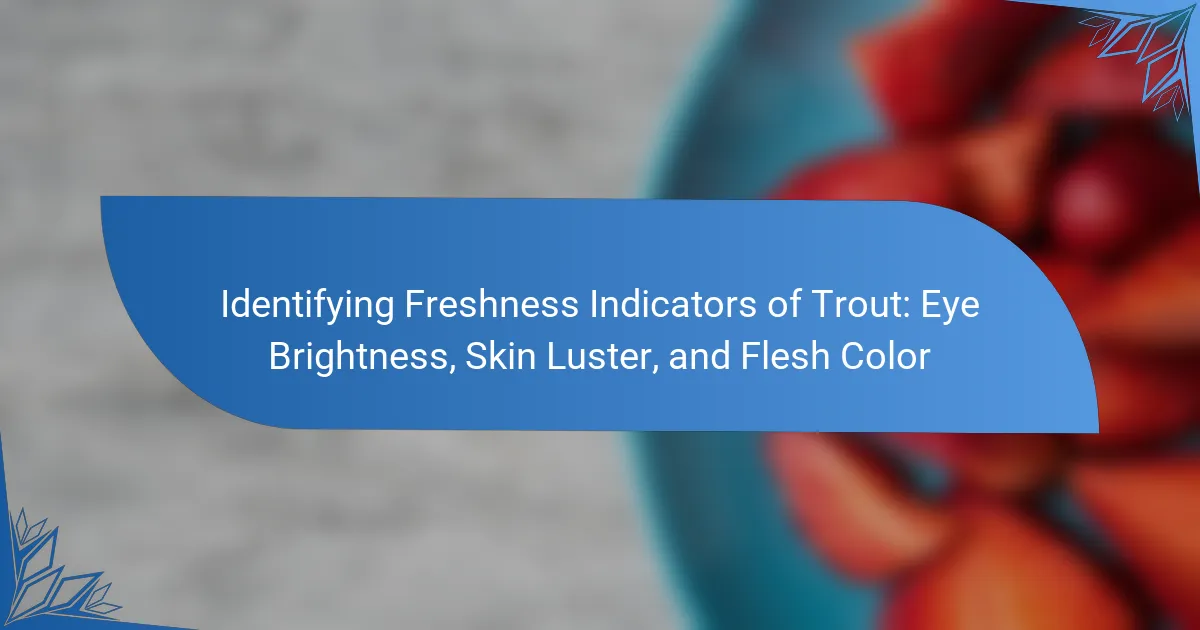
What are the Freshness Indicators of Snapper?
Freshness indicators of snapper include bright, clear eyes, vibrant flesh color, and a clean, ocean-like smell. Clear eyes indicate freshness, while dull or sunken eyes suggest age. Vibrant flesh color, typically pinkish or reddish, signifies quality. Any discoloration may indicate spoilage. A clean smell is essential; a strong fishy odor suggests the fish is no longer fresh. These indicators help consumers assess the quality of snapper before purchase.
Why is Freshness Important in Snapper?
Freshness is crucial in snapper because it directly affects taste and safety. Fresh snapper has a mild, sweet flavor and firm texture. As snapper ages, it can develop off-flavors and a mushy consistency. Additionally, older fish pose a higher risk of foodborne illness. Freshness indicators include bright, clear eyes and vibrant flesh color. According to the USDA, fresh fish should be consumed within two days of purchase for optimal quality. Proper handling and storage further ensure the snapper’s freshness.
How does Freshness Affect the Quality of Snapper?
Freshness significantly affects the quality of snapper. Fresh snapper exhibits firm flesh, bright color, and a clean smell. As snapper ages, its flesh becomes softer and may develop a dull appearance. The eyes of fresh snapper are clear and bulging, indicating vitality. In contrast, older snapper has sunken, cloudy eyes. Fresh snapper has a mild, ocean-like scent. If the fish smells sour or overly fishy, it is likely not fresh. Studies show that freshness directly correlates with flavor and texture, impacting culinary experiences.
What Risks are Associated with Consuming Non-Fresh Snapper?
Consuming non-fresh snapper poses several health risks. The primary risk is foodborne illness due to bacterial contamination. Non-fresh fish can harbor pathogens like Salmonella and Listeria. These bacteria can lead to severe gastrointestinal symptoms. Additionally, non-fresh snapper may contain higher levels of histamine. Histamine can cause scombroid poisoning, resulting in allergic reactions. Another concern is the potential accumulation of toxins. Fish that are not fresh may accumulate harmful substances like mercury. This can lead to long-term health issues. Eating non-fresh snapper can also lead to off-flavors and unpleasant textures. These factors contribute to a negative dining experience.
What are the Key Indicators of Freshness in Snapper?
The key indicators of freshness in snapper include bright, clear eyes, vibrant flesh color, and a clean, ocean-like smell. Fresh snapper should have eyes that are bulging and clear, indicating it has not been frozen or stored for long. The flesh should be firm and have a translucent appearance, with a pinkish or reddish hue. An off or sour smell indicates spoilage, while a fresh snapper should smell like the sea. These indicators are essential for determining the quality and safety of the fish for consumption.
How does Flesh Color Indicate Freshness in Snapper?
Flesh color is a key indicator of freshness in snapper. Fresh snapper typically exhibits a vibrant pink to red hue. This coloration suggests that the fish has not been exposed to prolonged storage or spoilage. Dull or faded flesh color indicates that the snapper may be old or less fresh. Studies show that the flesh color can change due to oxidation and microbial activity. Maintaining a bright color is essential for quality assessment. Therefore, consumers should look for snapper with rich, consistent color as a sign of optimal freshness.
What Role Does Eye Clarity Play in Assessing Snapper Freshness?
Eye clarity is a critical indicator of snapper freshness. Clear, bulging eyes suggest that the fish is fresh. In contrast, cloudy or sunken eyes indicate that the fish is likely not fresh. Fresh snapper should have bright, shiny eyes. This clarity is due to the fish’s health and the time since it was caught. Research shows that eye clarity deteriorates rapidly after death. Therefore, assessing eye clarity is essential for determining snapper quality.
How Can Smell Be Used to Determine the Freshness of Snapper?
Smell can be used to determine the freshness of snapper by assessing its odor. Fresh snapper typically has a mild, ocean-like scent. If the fish emits a strong, sour, or ammonia-like smell, it indicates spoilage. The presence of off-putting odors suggests bacterial growth or decomposition. Research shows that fresh fish should not have any strong or unpleasant smells. Therefore, a pleasant, light aroma is a reliable indicator of freshness in snapper.

How Can You Assess the Freshness of Snapper?
To assess the freshness of snapper, examine its flesh color, eye clarity, and smell. Fresh snapper has vibrant, translucent flesh that is firm to the touch. The eyes of fresh snapper should be clear and bulging, not cloudy or sunken. Additionally, fresh snapper emits a mild, ocean-like smell. If the fish has a strong, fishy odor, it is likely not fresh. These indicators are essential for determining the quality of snapper.
What Steps Should You Take to Evaluate Snapper Freshness?
To evaluate snapper freshness, check the flesh color, eye clarity, and smell. Fresh snapper has bright, translucent flesh that appears moist. Dull or discolored flesh indicates age or spoilage. The eyes of fresh snapper should be clear and bulging. Cloudy or sunken eyes suggest the fish is no longer fresh. Additionally, fresh snapper has a mild, ocean-like smell. A strong, fishy odor is a sign of deterioration. These indicators help ensure the snapper is safe and enjoyable to eat.
What Visual Cues Should You Look for in Snapper Flesh?
Fresh snapper flesh should appear translucent and moist. Look for a bright, vibrant color, typically ranging from pink to red. The flesh should not have any browning or dullness. Additionally, it should feel firm to the touch. If the flesh appears mushy, it may indicate spoilage. Clear, shiny skin is another positive visual cue. Lastly, check for any discoloration or dark spots, as these can signify aging or poor quality.
How Can You Test Eye Clarity in Snapper?
To test eye clarity in snapper, observe the eyes for clarity and brightness. Fresh snapper should have clear, bulging eyes. Dull or sunken eyes indicate a lack of freshness. Additionally, check for any cloudiness or discoloration. These characteristics are essential indicators of the fish’s quality. Studies show that eye clarity is a reliable freshness indicator in seafood.
What Smell Characteristics Indicate Fresh Snapper?
Fresh snapper has a clean, mild ocean smell. This scent indicates that the fish is not spoiled. Fresh snapper should not have a strong or fishy odor. A pungent smell suggests that the fish is old or has begun to decompose. Additionally, fresh snapper may have a slight sweetness in its aroma. This characteristic is often associated with high-quality seafood. The absence of ammonia or sour notes further confirms freshness. These smell characteristics are crucial for assessing the quality of snapper before purchase or consumption.
What Common Mistakes Should You Avoid When Assessing Snapper Freshness?
Common mistakes to avoid when assessing snapper freshness include overlooking flesh color, ignoring eye clarity, and neglecting smell. Fresh snapper should have bright, vibrant flesh. Dull or discolored flesh indicates age or spoilage. Eye clarity is crucial; clear, bulging eyes signify freshness. Cloudy or sunken eyes suggest the fish is not fresh. Additionally, smell plays a vital role. Fresh snapper should have a mild, ocean-like scent. A strong, fishy odor is a clear sign of spoilage. Avoid these mistakes to ensure you select the freshest snapper available.
How Can Misinterpretation of Flesh Color Lead to Errors?
Misinterpretation of flesh color can lead to errors in assessing snapper freshness. Flesh color may vary due to factors like species, diet, and handling. A pale or dull color may be wrongly interpreted as freshness. Conversely, vibrant color may mislead consumers into thinking the fish is fresh when it is not.
Inaccurate assessments can result in poor purchasing decisions. Studies show that consumers often associate bright colors with quality. This can lead to the selection of fish that is actually past its prime. Misinterpretation affects both consumer satisfaction and food safety.
Proper training in identifying true flesh color is essential for retailers. Awareness of natural color variations can mitigate these errors.
What Are the Pitfalls of Ignoring Eye Clarity?
Ignoring eye clarity in snapper can lead to purchasing inferior quality fish. Dull or cloudy eyes indicate that the fish is no longer fresh. Fresh snapper should have clear, bulging eyes. The presence of cloudy eyes often correlates with a decline in overall quality. Consuming fish that is not fresh can pose health risks. Bacteria can proliferate in fish that has surpassed its freshness. This can lead to foodborne illnesses. Therefore, assessing eye clarity is essential for ensuring quality and safety.

What Best Practices Should You Follow for Ensuring Snapper Freshness?
To ensure snapper freshness, store it at temperatures below 32°F. This temperature slows bacterial growth significantly. Use ice to maintain low temperatures if necessary. Inspect the flesh for firmness; fresh snapper should feel solid and bounce back when pressed. Examine the skin; it should appear shiny and moist. Check the eyes; they must be clear and bulging, indicating freshness. Fresh snapper should emit a mild, ocean-like smell, not a strong fishy odor. These practices help maintain the quality and safety of the fish.
How Can Proper Storage Maintain Snapper Freshness?
Proper storage can significantly maintain snapper freshness. Keeping snapper at a temperature of 32°F to 36°F slows bacterial growth. Using ice to pack the snapper helps preserve its texture and flavor. Wrapping the fish in moisture-resistant paper prevents freezer burn. Vacuum sealing can extend shelf life by removing air exposure. Storing snapper away from strong odors prevents flavor contamination. Consuming snapper within two days of purchase ensures optimal freshness. These methods collectively contribute to retaining the quality and safety of snapper.
What Temperature Should Snapper Be Stored At?
Snapper should be stored at a temperature of 32°F to 39°F (0°C to 4°C). This temperature range helps maintain the fish’s freshness and quality. Storing snapper at this temperature slows bacterial growth and preserves its texture. Keeping snapper cold is crucial for food safety. According to the USDA, fish should be refrigerated promptly after purchase. Proper storage temperature ensures that snapper remains safe for consumption.
How Long Can Snapper Be Kept Fresh?
Snapper can be kept fresh for up to two days when stored properly in the refrigerator. Fresh snapper should be kept at a temperature below 40°F (4°C). It is essential to store it in an airtight container or tightly wrapped in plastic wrap. The flesh should appear firm and moist, with a translucent color. Additionally, the eyes should be clear and bright, and there should be no off-putting smells. These characteristics indicate that the fish is still fresh and safe for consumption.
What Tips Can Help You Select the Freshest Snapper at the Market?
To select the freshest snapper at the market, look for bright, clear eyes. Fresh snapper should have a vibrant color, typically pinkish or red. The flesh should be firm and bounce back when pressed. Additionally, fresh snapper has a clean, ocean-like smell. Avoid snapper with dull eyes or a strong fishy odor. The skin should appear shiny and moist. Always check for signs of browning or discoloration. These indicators help ensure you choose the freshest snapper available.
What Signs of Freshness Should You Ask Your Fishmonger About?
Ask your fishmonger about the flesh color, eye clarity, and smell of the snapper. Fresh snapper should have bright, translucent flesh. The color should be vibrant and free from browning or discoloration. Clear, bulging eyes indicate freshness. Dull or sunken eyes suggest age. Additionally, fresh snapper should have a clean, ocean-like smell. A strong or sour odor indicates spoilage. These indicators are essential for assessing the freshness of snapper.
How Can You Compare Different Snapper Options Effectively?
To compare different snapper options effectively, assess key freshness indicators. Evaluate the flesh color; fresh snapper should have a vibrant, translucent appearance. Check the eye clarity; bright, clear eyes indicate freshness, while cloudy eyes suggest aging. Smell the snapper; a fresh fish should have a mild, ocean-like scent, not a strong or fishy odor. These indicators help determine the quality of snapper. Studies show that these freshness indicators are reliable for assessing seafood quality.
The main entity of this article is snapper, a popular fish known for its culinary qualities. The article focuses on assessing the freshness indicators of snapper, specifically examining attributes such as flesh color, eye clarity, and smell. Key indicators include vibrant pinkish or reddish flesh, clear and bulging eyes, and a mild ocean-like scent, all of which signify quality and safety. The content also highlights the importance of freshness for taste and health, detailing risks associated with consuming non-fresh snapper and best practices for selecting and storing it properly.



